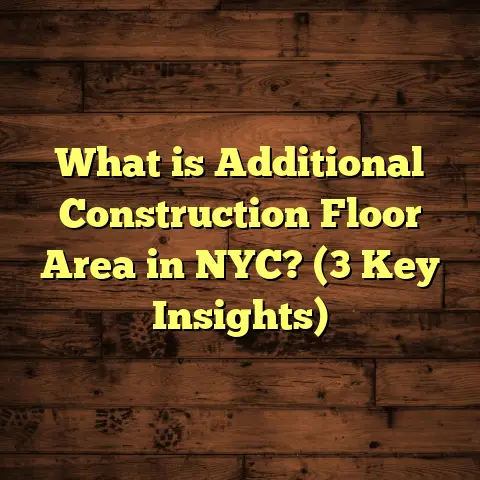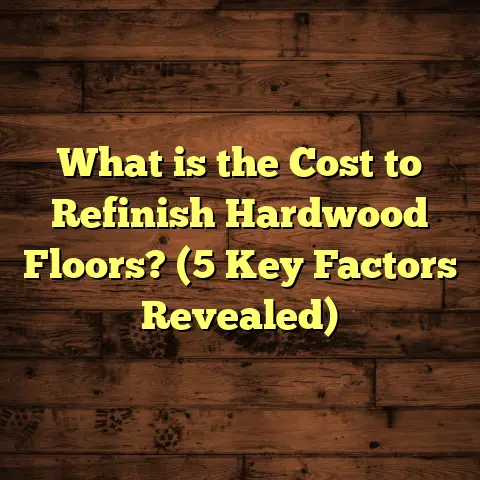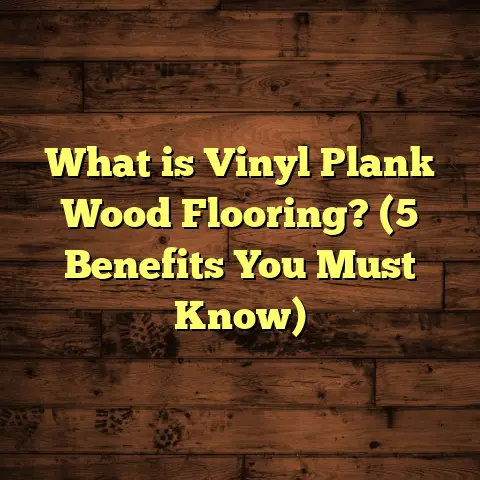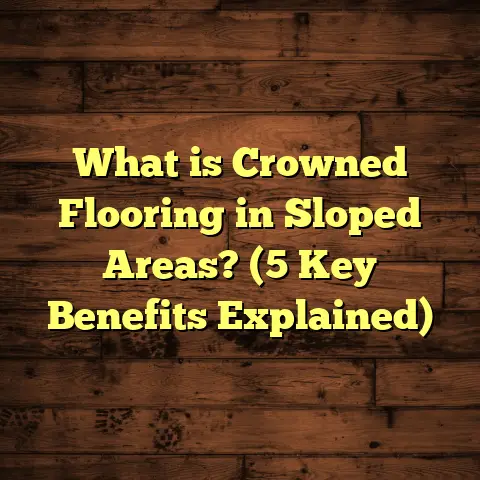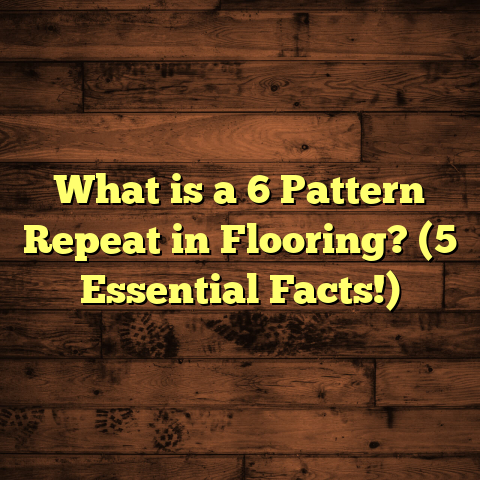What is Floor Moulding? (5 Types You Need for Perfect Decor)
I remember the first time I took on a flooring project and realized how much the small details like floor moulding could change the whole look of a room. If you’re like me, you might have wondered what exactly floor moulding is and why it’s so important for that polished finish. Let me walk you through everything I’ve learned about floor moulding, including different types you might need to make your space look just right.
What Is Floor Moulding?
Floor moulding is a type of trim installed where the floor meets the wall or at the edges of floors. Its main job is to cover the gaps between the flooring and the wall, hiding expansion gaps and uneven cuts. But beyond functionality, floor moulding plays a big role in the overall decor by adding a finishing touch that ties everything together.
Technically speaking, floor moulding comes in various shapes and sizes, often made from wood, MDF (medium-density fiberboard), vinyl, or even metal. The manufacturing process varies: solid wood mouldings are typically cut and shaped on molding machines, while MDF or vinyl ones are extruded or pressed into shape.
From my experience, choosing the right moulding isn’t just about style; it’s also about matching the material to your flooring type and room conditions. For example, hardwood floors pair beautifully with wooden mouldings, while vinyl floors often look better with flexible PVC trims.
Why Floor Moulding Matters
You might ask: why spend time and money on something as small as moulding? Well, without it, floors can look unfinished or sloppy. Plus, floor mouldings protect walls from damage caused by furniture, vacuum cleaners, or everyday wear and tear.
When I worked on my own hardwood flooring installation, I noticed how the right quarter round moulding not only covered the expansion gap but also made the room feel warmer and more inviting. That little detail made a big difference.
5 Types of Floor Moulding You Need for Perfect Decor
To get that perfect finish in your home, understanding the different types of floor moulding is key. Here’s what I recommend based on my projects:
1. Baseboard Moulding
This is probably the most common type of floor moulding you’ll see in homes. Baseboards run along the bottom of the walls and cover gaps between the floor and wall.
- Specifications: Usually 3 to 8 inches high.
- Materials: Wood (oak, pine), MDF, PVC.
- Manufacture: Made by cutting wood boards to shape and sanding smooth; MDF versions are pressed and primed for painting.
Baseboards help protect walls from kicks and scuffs. When installing hardwood floors, baseboards cover expansion spaces up to 3/4 inch wide. I often use baseboards with a slight bevel or rounded edge for a softer look.
I recall a project where the client wanted something with a bit of character but still simple enough to not overpower the room. We chose a colonial-style baseboard that was about 5 inches tall with subtle curves. It complemented their hardwood floors perfectly and gave their living room a classic yet cozy ambiance.
2. Quarter Round Moulding
A quarter round is a curved moulding that fits into corners between baseboards and floors. It’s rounded on one side and flat on the other two.
- Specifications: Typically 3/4 inch by 3/4 inch.
- Materials: Wood, MDF, vinyl.
- Manufacture: Cut from solid wood or extruded in vinyl.
I usually recommend quarter round when you want to hide larger expansion gaps or uneven cuts along hardwood or laminate floors. It’s easy to install with finishing nails or adhesive.
One time, I worked on a renovation where the old flooring was uneven near the walls after new hardwood was installed. Using quarter round moulding helped mask those imperfections without having to redo any flooring. It was a simple fix that saved time and money.
3. Shoe Moulding
Shoe moulding looks similar to quarter round but has a slightly thinner profile and more subtle curve.
- Specifications: Around 1/2 inch thick.
- Materials: Wood or MDF.
- Manufacture: Similar to quarter round but thinner.
This type is great when baseboards are already installed but don’t cover enough gap between floor and wall. In my experience, shoe moulding works well for floating floors like laminate because it allows room for movement.
I remember advising a client who had wide gaps after installing laminate floors under existing baseboards. Adding shoe molding was an easy solution that didn’t require removing or replacing the baseboards.
4. T-Moulding
T-moulding is used to join two flooring surfaces at the same height, such as between two rooms or in doorways.
- Specifications: Width varies but generally around 1 to 2 inches.
- Materials: Wood, laminate, vinyl.
- Manufacture: Cut from wood or laminated materials shaped into a T profile.
I’ve used T-moulding when transitioning between hardwood and tile floors. It creates a clean, safe edge that prevents tripping hazards.
For example, in one of my kitchen remodels where vinyl plank met ceramic tile in the adjoining dining area, T-moulding provided a neat dividing line while allowing both types of flooring to expand naturally.
5. Reducer Moulding
Reducer mouldings bridge flooring surfaces of different heights—say from thick hardwood to thinner vinyl.
- Specifications: Tapers from thick edge down to thin edge.
- Materials: Wood or laminate.
- Manufacture: Shaped on molding machines with a sloped profile.
This is essential when your floors meet uneven surfaces. I once tackled a renovation where a new hardwood floor met existing vinyl at lower height; using reducer moulding saved me from a potentially dangerous step-down edge.
Technical Insights and Manufacturing Details
I’ve spent hours reading up on how these mouldings are made because it helps me pick the right product for each job. Here’s some inside info:
- Wood Mouldings: Typically made from hardwoods like oak or maple for durability. The wood is kiln-dried to reduce moisture content below 8%, preventing warping after installation.
- MDF Mouldings: Manufactured by compressing wood fibers with resin binders under heat and pressure. This creates smooth surfaces ideal for painting but less resistant to moisture.
- Vinyl Mouldings: Extruded from PVC compounds mixed with stabilizers and pigments. Vinyl is flexible and water-resistant, perfect for bathrooms or basements.
The molding machines use cutters shaped to produce profiles like quarter rounds or baseboards in one pass. After cutting, products are sanded or primed before packaging.
Knowing these details helps me advise clients better, especially on moisture-sensitive areas like bathrooms where vinyl or PVC is often the best choice.
Why Material Matters
One thing I learned early is that not all mouldings react the same way when exposed to heat, humidity, or heavy foot traffic. Wood expands and contracts with moisture changes; MDF can swell if exposed to water; vinyl holds up better but might not blend well with traditional decor.
For example, in my work on a coastal home where humidity was high year-round, using PVC mouldings rather than wood saved lots of headaches due to rot and warping issues.
Environmental Considerations
I have also noticed an increasing trend toward eco-friendly materials in flooring accessories. Some manufacturers now offer mouldings made from reclaimed wood or recycled composites which offer durability while reducing waste.
When helping clients who want sustainable options, I point them toward these newer products which combine quality with environmental responsibility.
Personalized Stories And Lessons Learned
Let me share some stories that helped shape my understanding of floor mouldings over time:
- Early in my career, I installed baseboards without leaving enough space for floor expansion during winter months. The result? The hardwood buckled slightly near walls due to lack of movement room. Since then, I always stress spacing guidelines to clients.
- Another memorable project involved restoring an old Victorian home where original ornate baseboard profiles were no longer available. We custom-milled new mouldings based on historical designs which preserved authenticity while integrating modern materials underneath.
- In contrast, for some ultra-modern interiors I’ve worked on recently, minimalistic square-edged shoe mouldings matched sleek floors perfectly without distracting from clean lines.
These experiences taught me that mouldings are more than just functional—they’re part of your home’s personality.
Cost Breakdown & Budget Tips
Budgeting for floor mouldings can sometimes be overlooked but can add up quickly depending on material choice and length needed.
Here’s what I typically see for costs per linear foot:
| Moulding Type | Material | Cost Range (USD) | Installation Cost (USD/ft) |
|---|---|---|---|
| Baseboard | Wood | $2 – $6 | $1 – $3 |
| Quarter Round | Wood/MDF | $0.75 – $3 | $0.75 – $2 |
| Shoe Moulding | MDF | $0.50 – $2 | $0.75 – $2 |
| T-Moulding | Wood/Laminate | $1 – $4 | $1 – $3 |
| Reducer | Wood | $1 – $4 | $1 – $3 |
Labor costs vary by region but generally run around $1-$3 per foot depending on complexity.
How FloorTally Helps Me Keep Costs Realistic
One tool I’ve found really useful is FloorTally. It helps me calculate precise material needs including waste factors and labor costs based on local rates. This saves me from underestimating expenses or ordering too much material that ends up unused.
For example, for a recent project installing engineered hardwood with shoe moulding throughout 800 square feet of space, FloorTally helped me generate an accurate budget within minutes — factoring in local labor costs and expected waste percentage around 7%. Having this kind of data upfront builds trust with clients and prevents surprises down the line.
Installation Tips From Experience
Installing floor mouldings may seem straightforward but doing it right requires attention:
- Always measure twice before cutting mouldings.
- Use finishing nails rather than regular nails; they leave smaller holes easier to fill.
- Apply painter’s caulk along edges for seamless finish.
- Paint or stain mouldings before installation when possible for cleaner results.
- Use adhesive for extra hold in high-traffic areas or where nails can’t be used.
One thing I learned is that pneumatic nail guns can speed up installation dramatically compared to hammer and nails—especially on large jobs—but you need experience not to damage delicate trim pieces.
How To Maintain Floor Mouldings
Maintenance is simple but important if you want your mouldings to last:
- Dust regularly using microfiber cloths or vacuum attachments.
- Clean painted surfaces with mild soap solution; avoid harsh chemicals.
- For wood mouldings, occasionally polish with appropriate wood care products.
- Inspect periodically for signs of damage like cracks or loose nails and repair promptly.
In one project I managed for an elderly client, we replaced old damaged baseboards with new ones made from durable oak and sealed them properly. Years later they still looked great thanks to regular upkeep advice I provided.
Design Ideas: Matching Mouldings With Your Decor
Choosing mouldings isn’t only about function—it’s part of your interior design statement:
- For traditional homes: Go for taller baseboards with ornate profiles.
- Modern styles: Opt for simple square-edge shoe mouldings.
- Rustic looks: Reclaimed wood baseboards with visible grain work well.
- Minimalist: Thin reducers and flush T-mouldings keep lines clean.
I remember helping a friend who wanted Scandinavian-style interiors using whitewashed floors paired with simple white shoe moldings — it gave her rooms a bright airy feel without clutter.
Case Studies: Real Projects With Floor Mouldings
Case Study 1: Open Concept Living Space
In this project, we installed wide plank engineered hardwood across an open living/dining/kitchen area totaling about 1200 sq ft. We chose 6-inch colonial baseboards stained to match flooring plus quarter round for gaps in corners.
The client wanted warmth and elegance; this combination delivered exactly that while hiding minor gaps in subfloor transitions.
Case Study 2: Basement Renovation With Vinyl Flooring
A damp basement space was upgraded using waterproof vinyl planks. We used flexible vinyl baseboards resistant to moisture plus T-mouldings where floor met stairs and laundry area tiles.
This prevented water damage common with wood products here and maintained clean lines despite uneven concrete subfloor.
Case Study 3: Bathroom Remodel With Tile & Wood Floors
For a bathroom remodel adjoining hardwood floors in adjacent rooms we installed custom reducers matching hardwood color between tile edges and wood planks—eliminating tripping hazards while preserving aesthetics.
Floor mouldings might seem like small details but they’re key for making your flooring look professional and finished. From baseboards that protect your walls to reducers that smooth out height differences, each type has its own purpose.
I hope my experience gives you more confidence when selecting floor mouldings for your next project. If you want your home to look sharp and stylish with durable finishes, don’t overlook these essential elements!
If you have questions about specific types or installation tips, just ask—I’m happy to share whatever I’ve learned over years in flooring work!
Expanding Further: Deep Technical Details & Advanced Tips
Let’s get into even more detail about materials, manufacturing methods, installation challenges, environment considerations, costs around custom millwork, and DIY vs professional choices…
Manufacturing Processes Explained
Understanding how different types of floor mouldings are created helps appreciate their qualities:
Solid Wood Mouldings
These start as rough lumber—oak, maple, pine—selected for grain consistency and absence of defects like knots. Kiln drying reduces moisture content below 8% to avoid shrinkage after installation.
Next step is milling: large molding machines use specialized cutter heads shaped according to profile designs (beveled edges, ogee curves). Profiles are cut in multiple passes depending on complexity.
Finally sanding smooths surfaces ready for staining or finishing before packaging for sale.
MDF Mouldings
MDF is engineered wood made by breaking down hardwood fibers combined with resin binders then compressed under heat & pressure into dense sheets.
Sheets are cut into strips then shaped using router bits designed for profile edges like quarter rounds or shoe moldings.
MDF surfaces are smooth but absorbent; they receive primer coats to allow paint adhesion since raw MDF swells if wet.
Vinyl/PVC Mouldings
Vinyl profiles are created through extrusion where hot PVC compound is forced through shaped dies creating continuous lengths of trim with consistent profiles such as baseboard or quarter rounds.
Stabilizers prevent warping; pigments add color either solid or surface coated post-extrusion.
These are flexible enough to curve around corners easily—a big advantage in bathrooms or curved staircases.
Advanced Installation Insights
Here are some lessons from challenging installs:
- Uneven Walls/Floors: Sometimes walls aren’t perfectly straight requiring scribing baseboards so they fit tight without gaps.
- Corners: Inside corners should be coped (cut along profile shape) rather than mitered for tighter seams; outside corners usually mitered at 45 degrees.
- Expansion Gaps: For floating floors (laminate/vinyl), leave recommended expansion gaps (typically 1/4 inch) between flooring edge & walls before installing shoe or quarter round covering gap without restricting movement.
- Nail Placement: Avoid nailing too close to edge of thin moldings which may split; use glue as supplementary hold especially on MDF products which can be fragile during nailing.
In one job with very narrow shoe moldings (3/8 inch), I had to use tiny brad nails plus adhesive glue for secure hold since nailing alone risked splitting trim pieces.
Environmental & Durability Factors To Think About
Homes in humid climates require different choices than dry ones:
- Wood mouldings can warp or swell if not properly sealed against moisture.
- MDF is vulnerable around wet areas unless specially treated.
- Vinyl/PVC trims are water-resistant but may fade over years if exposed directly to UV light through windows.
For outdoor covered porches where flooring meets siding walls, composite trims made from wood-plastic blends offer good weather resistance combined with natural look—something worth considering if you have exterior wooden decks connecting indoors.
Cost Management & Value Engineering
Spending on high-quality mouldings can increase upfront costs but save money long term by reducing maintenance needs:
- Prefinished wooden baseboards cost more initially but save labor painting time onsite.
- MDF moldings cost less but may need repainting more often due to surface wear.
- Custom millwork profiles can be pricey but add unique character raising home value especially in historic homes or luxury renovations.
Tracking all these variables carefully using tools like FloorTally helps me balance budget vs quality choices tailored per client preferences without surprises later during install phase.
DIY vs Professional Installation
Thinking about doing your own molding installation? Here’s my take:
DIY Benefits:
- Can save money if you have basic carpentry skills.
- Smaller rooms/straight runs are manageable projects.
Challenges:
- Achieving professional-looking corners requires practice.
- Mistakes waste materials increasing costs anyway.
- Some tools like miter saws & nail guns are needed upfront investment.
For large areas or complicated profiles I always recommend hiring pros who bring experience plus specialized tools ensuring clean finish quickly—plus warranty coverage if anything goes wrong later on.
Maintenance Tips To Keep Your Floor Mouldings Looking New
Keeping your trim looking fresh is easier than many think:
- Wipe down regularly with damp cloths rather than harsh chemicals which strip paint/finiish layers.
- Touch up paint scuffs periodically rather than waiting for full repainting jobs every few years.
- Use wood fillers on nail holes/cracks immediately after installation followed by sanding before painting/staining.
I once had a client whose dog scratched baseboards heavily; we applied clear protective polyurethane coat over painted trims which reduced future damage noticeably without changing color much at all.
Wrapping Up My Thoughts On Floor Moulding Essentials
Floor moulding might seem like just trim pieces tucked away out of sight but their impact is huge—both practical & aesthetic.
Choosing correct types based on flooring material & room use ensures durability while adding style that completes your décor vision perfectly.
From my personal experiences managing dozens of projects spanning historic restorations through modern urban condos—I can say mastering floor moulding selection & installation makes all difference between “meh” flooring jobs vs ones clients rave about years later.
If you feel overwhelmed by options or want help estimating costs accurately (including labor/materials/waste), tools like FloorTally have become indispensable allies helping me plan smarter budgets fast without guesswork.
Feel free to reach out anytime if you want tailored advice about your specific project—I’m always happy sharing what works best after all these years working hands-on in flooring trades!
Thanks for sticking through this detailed guide! What part surprised you most? Or do you want tips on sourcing quality moldings near your area? Just let me know!

